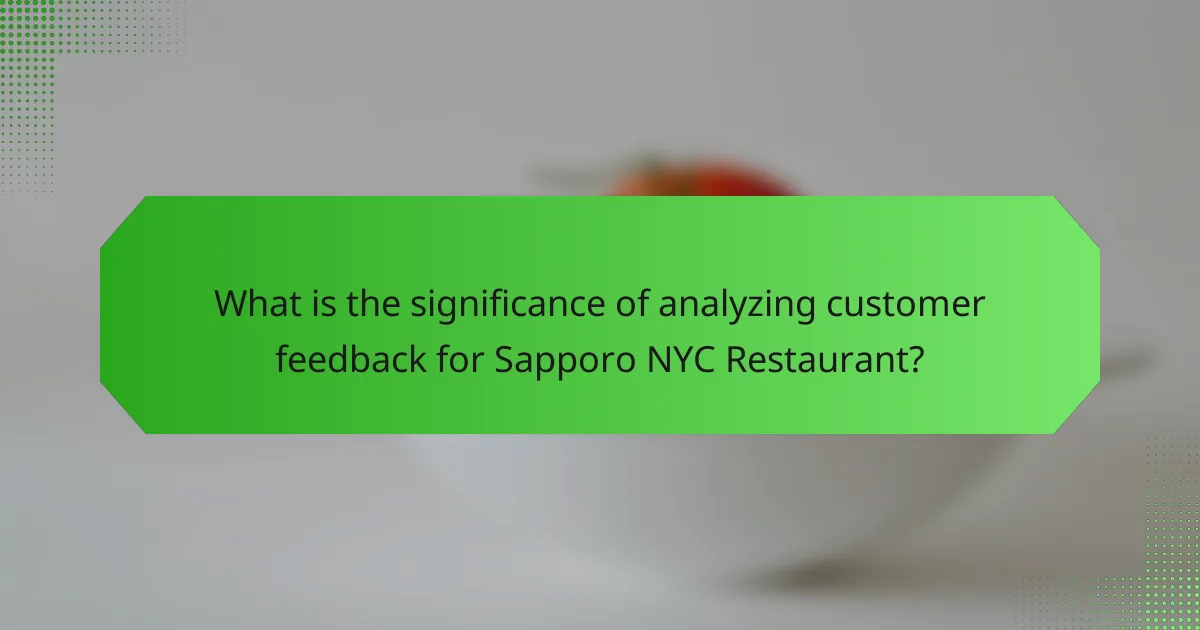
What is the significance of analyzing customer feedback for Sapporo NYC Restaurant?
Analyzing customer feedback is crucial for Sapporo NYC Restaurant. It helps identify strengths and weaknesses in food quality. Feedback reveals customer preferences and satisfaction levels. This information guides menu improvements and service enhancements. Additionally, it fosters customer loyalty by addressing concerns. Research shows that 70% of customers are more likely to return if their feedback is acknowledged. Effective analysis can lead to higher ratings and better online reviews. Thus, customer feedback analysis directly impacts the restaurant’s success and reputation.
How does customer feedback impact restaurant operations?
Customer feedback significantly impacts restaurant operations by guiding improvements in food quality, staff attentiveness, and cleanliness. Positive feedback can reinforce successful practices, while negative feedback highlights areas needing change. For example, a survey by the National Restaurant Association found that 70% of customers are influenced by online reviews. This data shows that restaurants can increase customer satisfaction by addressing feedback promptly. Implementing changes based on customer input can lead to enhanced dining experiences and repeat business. Thus, customer feedback serves as a critical tool for operational adjustments in restaurants.
What are the key areas of focus in customer feedback?
The key areas of focus in customer feedback include food quality, staff attentiveness, and cleanliness. Food quality refers to the taste, presentation, and freshness of dishes served. Customers often evaluate whether their meals meet expectations based on these factors. Staff attentiveness involves the level of service provided by waitstaff. This includes responsiveness, friendliness, and the ability to address customer needs promptly. Cleanliness is crucial as it reflects the overall hygiene and maintenance of the restaurant. Customers assess both the dining area and restrooms for cleanliness. These areas significantly impact customer satisfaction and repeat business. Studies show that 70% of customers cite food quality as the primary reason for dining out.
How can feedback improve overall customer experience?
Feedback can significantly enhance overall customer experience by identifying areas for improvement. It allows businesses to understand customer preferences and expectations. For instance, feedback on food quality can lead to menu adjustments. This can increase customer satisfaction and repeat visits. Additionally, feedback regarding staff attentiveness can highlight training needs. Improving staff performance directly impacts customer interactions. Cleanliness feedback can prompt timely maintenance and hygiene practices. Research shows that 70% of customers who experience a positive change are likely to return. Therefore, actively seeking and implementing feedback fosters a culture of continuous improvement.
Why is food quality a crucial aspect of customer feedback?
Food quality is a crucial aspect of customer feedback because it directly impacts customer satisfaction and loyalty. High food quality often leads to positive dining experiences. Customers are more likely to return if they enjoy the food. Studies show that 70% of customers cite food quality as a primary reason for their restaurant choices. Additionally, food quality influences online reviews and ratings. Poor food quality can result in negative feedback, affecting a restaurant’s reputation. Thus, monitoring food quality is essential for maintaining a competitive edge.
What attributes define food quality in a restaurant setting?
Food quality in a restaurant setting is defined by freshness, taste, presentation, and consistency. Freshness refers to the use of ingredients that are not expired or spoiled. Taste encompasses the balance of flavors and seasoning in the dishes served. Presentation involves the visual appeal of the food, including plating and garnishing. Consistency ensures that the same quality is maintained across different meals and visits. These attributes are crucial as they directly impact customer satisfaction and repeat business. Studies show that 70% of diners consider food quality the most important factor when choosing a restaurant.
How does food quality influence customer satisfaction?
Food quality significantly influences customer satisfaction. High-quality food meets or exceeds customer expectations. It affects taste, freshness, and presentation. According to a study by Kwortnik and Thompson, food quality directly correlates with customer loyalty. Customers are more likely to return when they enjoy their meals. Additionally, food quality impacts online reviews and restaurant ratings. Positive feedback often highlights the quality of dishes. In contrast, poor food quality can lead to negative experiences and complaints. Overall, maintaining high food quality is essential for customer satisfaction and retention.
What role does staff attentiveness play in customer feedback?
Staff attentiveness significantly influences customer feedback. Attentive staff can enhance customer satisfaction and create positive dining experiences. Research shows that 70% of customers cite staff service as a key factor in their overall satisfaction. When staff are attentive, they can anticipate needs and resolve issues promptly. This responsiveness often leads to favorable reviews and repeat business. Conversely, inattentive service can result in negative feedback and lost customers. A study by the Journal of Service Research found that service quality directly correlates with customer loyalty. Thus, staff attentiveness is crucial for generating positive customer feedback.
How can staff attentiveness be measured through feedback?
Staff attentiveness can be measured through customer feedback by analyzing specific comments and ratings. Customers often provide insights into their experiences, highlighting staff responsiveness and engagement. Surveys and review platforms can quantify these aspects with numerical ratings. High scores in service-related questions indicate effective attentiveness. Additionally, qualitative feedback can reveal recurring themes about staff behavior. For example, comments about prompt service or friendly interactions reflect attentiveness levels. Analyzing both quantitative and qualitative data provides a comprehensive view of staff performance. This method allows management to identify strengths and areas for improvement in staff attentiveness.
What impact does staff attentiveness have on repeat business?
Staff attentiveness significantly impacts repeat business. High levels of attentiveness lead to improved customer satisfaction. Satisfied customers are more likely to return. A study by the Cornell University School of Hotel Administration found that attentive service can increase customer loyalty. Specifically, 70% of customers cite service quality as a key reason for repeat visits. Additionally, attentive staff can address customer needs promptly, enhancing the overall dining experience. This creates a positive impression that encourages customers to return. Ultimately, attentiveness fosters a welcoming environment that promotes loyalty.
Why is cleanliness important in the context of customer feedback?
Cleanliness is crucial in the context of customer feedback because it directly impacts customer satisfaction and perception. A clean environment enhances the dining experience and reflects the establishment’s attention to detail. Studies show that 75% of customers consider cleanliness a top priority when evaluating a restaurant. Customers are likely to leave positive feedback if they perceive the restaurant as clean. Conversely, negative feedback often highlights cleanliness issues. This correlation can significantly influence a restaurant’s reputation and repeat business. Cleanliness thus serves as a foundational element in customer evaluations and overall business success.
What aspects of cleanliness do customers typically evaluate?
Customers typically evaluate several key aspects of cleanliness. These aspects include the overall appearance of the dining area. Customers look for cleanliness in tables, floors, and restrooms. They also assess the cleanliness of staff uniforms and personal hygiene. Sanitization practices, like visible cleaning schedules, are important to customers. The presence of trash and its management can influence perceptions of cleanliness. Customers may also consider the cleanliness of food preparation areas, if visible. These evaluations directly impact customer satisfaction and repeat business. Research shows that cleanliness is a top factor in dining experiences, influencing 75% of customer decisions.
How does cleanliness affect a restaurant’s reputation?
Cleanliness significantly impacts a restaurant’s reputation. Customers often associate cleanliness with food safety and quality. A clean environment fosters trust and encourages repeat visits. According to a survey by the National Restaurant Association, 75% of diners consider cleanliness a top priority. Poor cleanliness can lead to negative reviews and decreased customer loyalty. Unsanitary conditions may result in health code violations, further damaging reputation. Overall, maintaining high cleanliness standards is essential for a positive restaurant image.
How can feedback be effectively collected and analyzed?
Feedback can be effectively collected through surveys, comment cards, and online reviews. Surveys can be distributed via email or social media. They should include specific questions about food quality, staff attentiveness, and cleanliness. Comment cards can be placed on tables for immediate feedback. Online reviews can be monitored on platforms like Yelp and Google.
Analyzing feedback involves categorizing responses into themes. This can be done using qualitative analysis software. Quantitative data from surveys can be statistically analyzed for trends. Regularly reviewing feedback allows for timely improvements.
Research shows that 70% of customers prefer surveys for feedback collection (Source: SurveyMonkey, 2021). This method provides direct insights into customer experiences.
What methods are most effective for gathering customer feedback?
Surveys are among the most effective methods for gathering customer feedback. They can be conducted online or in-person. Surveys allow for structured questions that yield quantitative data. Another effective method is direct interviews, which provide qualitative insights. Focus groups also facilitate in-depth discussions about customer experiences. Social media monitoring captures real-time feedback from customers. Utilizing comment cards encourages spontaneous feedback during the dining experience. Each method has its strengths and can be tailored to specific feedback goals.
How can data analysis enhance the understanding of customer sentiments?
Data analysis enhances the understanding of customer sentiments by systematically interpreting feedback data. It identifies patterns in customer opinions and emotions. For example, sentiment analysis tools can quantify positive or negative feelings expressed in reviews. These tools utilize algorithms to analyze text from various sources, such as social media and online reviews.
By aggregating this data, businesses can pinpoint specific areas of concern, such as food quality or staff attentiveness. A study by McKinsey & Company highlights that companies using data-driven insights improve customer satisfaction by 20%. This demonstrates the effectiveness of data analysis in understanding and responding to customer sentiments.
What best practices can Sapporo NYC Restaurant implement based on customer feedback?
Sapporo NYC Restaurant can implement staff training programs based on customer feedback. This training should focus on improving service speed and attentiveness. Regularly scheduled training sessions can enhance staff skills. Feedback indicating slow service can guide specific areas of improvement.
Additionally, Sapporo can introduce a quality control system for food preparation. This system ensures consistency in food quality. Customer comments about food presentation and taste can inform menu adjustments.
Furthermore, Sapporo should maintain a rigorous cleaning schedule. Cleanliness was a common theme in customer feedback. Regular inspections can help uphold high hygiene standards.
Lastly, Sapporo can establish a feedback loop with customers. This can include follow-up surveys after dining experiences. Engaging with customers shows that their opinions are valued.
How can the restaurant prioritize improvements based on feedback trends?
The restaurant can prioritize improvements by analyzing feedback trends systematically. First, categorize feedback into key areas: food quality, staff attentiveness, and cleanliness. Next, identify recurring issues within each category. For instance, if multiple customers mention slow service, this indicates a need for staff training or process optimization. Additionally, quantify the feedback by tracking the frequency of specific comments over time. This data-driven approach enables the restaurant to focus on the most pressing concerns. Research shows that addressing top customer pain points can lead to a 20% increase in satisfaction scores. Prioritizing improvements based on clear feedback trends ultimately enhances overall customer experience.
What are effective strategies for communicating changes to customers?
Effective strategies for communicating changes to customers include clear messaging and timely updates. Utilize multiple channels such as email, social media, and in-store signage. Ensure the language is simple and direct to avoid confusion. Highlight the benefits of the changes to foster positive reception. Provide a rationale for the changes to build trust and transparency. Engage customers by inviting feedback on the changes. Monitor customer reactions to adjust communication strategies as needed. According to a study by the Harvard Business Review, effective communication can enhance customer satisfaction and loyalty.
Sapporo NYC Restaurant is the primary entity discussed in the article, focusing on the significance of analyzing customer feedback related to food quality, staff attentiveness, and cleanliness. The article outlines how customer feedback informs operational improvements, enhances dining experiences, and fosters customer loyalty. Key areas of focus include the attributes defining food quality, the impact of staff service on customer satisfaction, and the importance of maintaining cleanliness. Additionally, it highlights effective methods for collecting and analyzing feedback, as well as best practices for implementing changes based on customer insights.


